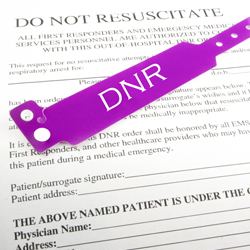Does Hospice Require You to Sign a DNR?
Advance directives are legal documents that inform medical professionals about a patient’s preferences for care in case they are unable to speak for themselves. Do Not Resuscitate (DNR) orders are among the most common of these directives.
Patients and their loved ones may have questions about these directives as they consider hospice services.
A typical concern among those seeking end-of-life care is whether a hospice provider requires a patient to submit a DNR to receive care.
To help you make a more informed decision about hospice, consider:
- How a DNR works
- What it means to have one
- Whether a DNR aligns with your or your loved one’s care goals
What Is a DNR Or DNI Order?
Do Not Resuscitate means exactly that. It is an order written by a physician and placed in the medical chart that instructs all medical staff not to try to revive a seriously ill patient if their breathing or heartbeat stops. This means physicians, nurses, and others, including emergency medical technicians, will not initiate any emergency life-saving procedures.
Generally, a DNR order is placed in a seriously ill patient’s chart before a medical crisis occurs.
A Do Not Intubate (DNI) order functions like a DNR with added allowances. Signing a DNI permits medical staff to attempt to revive a patient via cardiopulmonary resuscitation (CPR) methods, including chest compressions and cardiac drugs, but prohibits the placement of a breathing tube. Many people choose a DNI to avoid the potential complications that can arise from a breathing tube, including ventilator dependence.
Does Hospice Require a DNR Order?
VITAS does not require a DNR order before admitting a patient. Medicare-certified hospices do not require a DNR order, since it is understood by the patient and family that the patient will be receiving palliative, not curative, care.
VITAS and DNR Orders: Not Required
There’s no right answer to whether a seriously ill patient should be revived if their heart or lungs stop working.
Some people may never be ready to give up CPR, and they will have this preference noted in their medical records. Others see a DNR order in their chart as an assurance they will die a natural death when the time comes. Still others never make a decision, leaving it up to often-distraught or uninformed family members to decide in a crisis situation.
While some hospices may require a DNR before admittance, VITAS does not.
What Is A Full-Code Hospice Patient?
A full-code hospice patient is a patient who has indicated via advance directive or instruction to their provider that all resuscitative measures should be taken if their heartbeat or breathing stops. As with DNRs and DNIs, hospice patients may choose full-code status for a variety of personal reasons.
For some, full-code status offers a way to retain autonomy and exercise control over their end-of-life experience. Those who elect to be full code often find comfort in the idea of one last “safety net.” Whatever the patient’s reasoning, VITAS is committed to respecting personal choice and managing pain and symptoms on the patient’s terms.
Are Full-Code Hospice Patients More Likely to Extend Life?
Patients accept hospice services with a physician’s prognosis of 6 months or less and an understanding that they’ll receive palliative, rather than curative, care. Because of these factors, many patients choose not to be full code. A 2017 study of more than 25,000 hospice patients found that only 12.9% elected full-code status.

The same study found that full-code hospice patients were nearly twice as likely as DNR/DNI patients to be discharged alive from hospice care within two weeks of admission. While the study does not address the cause of this statistic, it’s possible that patients with full-code status are more likely to feel unsure about enrolling in hospice, and thus may be more likely to decline services after a short period.
Full-code status is unlikely to substantially increase the life expectancy of any hospice patient, but it should never be a barrier to receiving the care you or your loved want. In fact, research demonstrates that patients who receive hospice care near the end of life live longer on average—and with higher quality of life—than those who do not. The patient lives extended in this study were not due to resuscitation efforts.
DNR vs. CPR: What to Consider
Today CPR involves more than the commonly known mouth-to-mouth resuscitation and external chest compression of the past. Advances in medicine now allow more aggressive options for saving a life, including electric shock using paddles placed on the chest (defibrillation), open-chest heart massage, mechanical assistance from a ventilator, and the injection of medications directly into the heart. Additionally, CPR isn’t guaranteed to work and sometimes leaves the patient in worse condition.1
The Pros and Cons of CPR
The number one pro of CPR is that it can save your life. For individuals who are choking, drowning, having a heart attack or experiencing interrupted blood flow to the brain for any reason, every minute counts. Immediate CPR can prevent permanent brain damage. When CPR is successful, it can keep damage to a minimum by quickly restarting the heart to get blood flowing again. CPR is most successful on individuals who are healthy—whose bodies are not compromised by the frailness of advanced age, illness, or disease.
On the other hand, CPR can be difficult for the body to withstand. External chest compression can cause cracked or broken ribs. Contusions to the lungs from the force of CPR can leave the patient on a ventilator. CPR administered too late or incorrectly can leave a patient brain damaged or dead. Even mouth-to-mouth resuscitation can spread disease, especially if the patient has a weakened immune system.
The best-case scenario is to talk with your family and physician about what you would want long before you actually need to choose or decide. Having advance directives in place eases the burden of making these crucial end-of-life decisions on everyone involved.